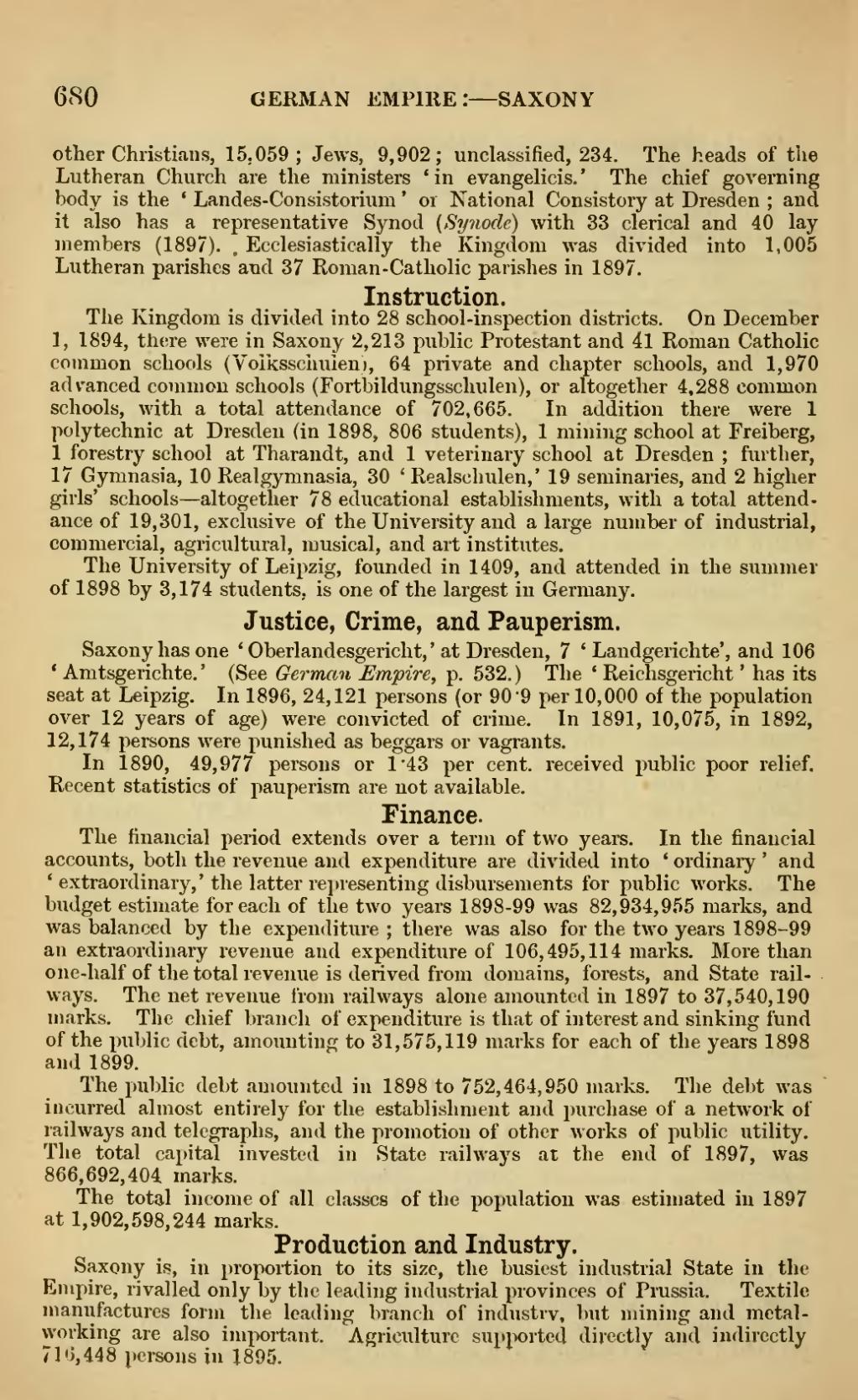6cS0 GERMAN empire: — SAXONY
other Christians, 15.059; Jews, 9,902; unclassified, 234. The heads of the Lutheran Church are the ministers ' in evangelicis. ' The chief governing body is the ' Landes-Consistorium ' or National Consistory at Dresden ; and it also has a representative Synod (Synocle) with 33 clerical and 40 lay members (1897). . Ecclesiastically the Kingdom was divided into 1,005 Lutheran parishes and 37 Roman-Catholic parishes in 1897.
Instruction.
The Kingdom is divided into 28 school-inspection districts. On December 1, 1894, there were in Saxony 2,213 public Protestant and 41 Roman Catholic common schools (Yoiksscimien), 64 private and chapter schools, and 1,970 advanced common schools (Fortbildungsschulen), or altogether 4,288 common schools, with a total attendance of 702,665. In addition there were 1 polytechnic at Dresden (in 1898, 806 students), 1 mining school at Freiberg, 1 forestry school at Tharandt, and 1 veterinary school at Dresden ; further, 17 Gymnasia, 10 Realgymnasia, 30 'Realschulen,' 19 seminaries, and 2 higher girls' schools — altogether 78 educational establishments, with a total attend- ance of 19,301, exclusive of the University and a large number of industrial, commercial, agricultural, musical, and art institutes.
The Universit}^ of Leipzig, founded in 1409, and attended in the summer of 1898 by 3,174 students, is one of the largest in Germany.
Justice, Crime, and Pauperism.
Saxony has one ' Oberlandesgericht, ' at Dresden, 7 ' Landgerichte', and 106
- Amtsgerichte, ' (See German Empire, p. 532.) The ' Reichsgericht ' has its
seat at Leipzig. In 1896, 24,121 persons (or 90 '9 per 10,000 of the population over 12 years of age) were convicted of crime. In 1891, 10,075, in 1892, 12,174 persons were punished as beggars or vagrants.
In 1890, 49,977 persons or 1*43 per cent, received public poor relief. Recent statistics of pauperism are not available.
Finance.
The financial period extends over a term of two years. In the financial accounts, both the revenue and expenditure are divided into ' ordinary ' and ' extraordinary,' the latter representing disbursements for public works. The budget estimate for each of the two years 1898-99 was 82,934,955 marks, and was balanced by the expenditure ; there was also for the two years 1898-99 an extraordinary revenue and expenditure of 106,495,114 marks. More than one-half of the total revenue is derived from domains, forests, and State rail- ways. The net revenue from railways alone amounted in 1897 to 37,540,190 marks. The chief branch of expenditure is that of interest and sinking fund of the public debt, amounting to 31,575,119 marks for each of the years 1898 and 1899.
The public debt amounted in 1898 to 752,464,950 marks. The debt was incurred almost entirely for the establishment and purchase of a network of railways and telegraphs, and the promotion of other works of public utility. The total capital invested in State railways at the end of 1897, was 866,692,404 marks.
The total income of all classes of the population was estimated in 1897 at 1,902,598,244 marks.
Production and Industry.
Saxony is, in proportion to its size, the busiest industrial State in the Empire, rivalled only by the leading industrial provinces of Prussia. Textile manufactures form the leading branch of industrv, but mining and metal- working are also important. Agriculture supported directly and indirectly 716,448 persons in 1895.

